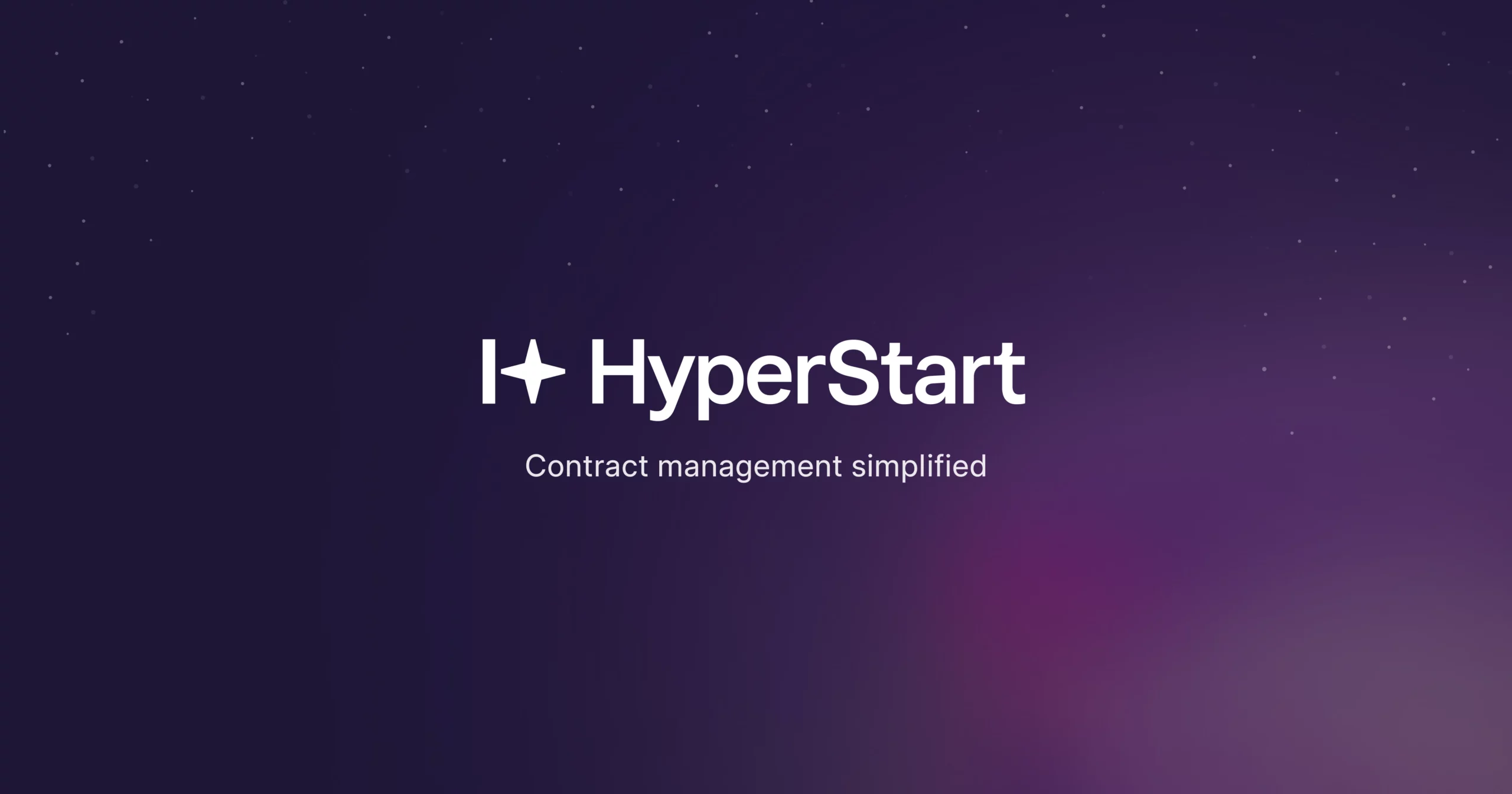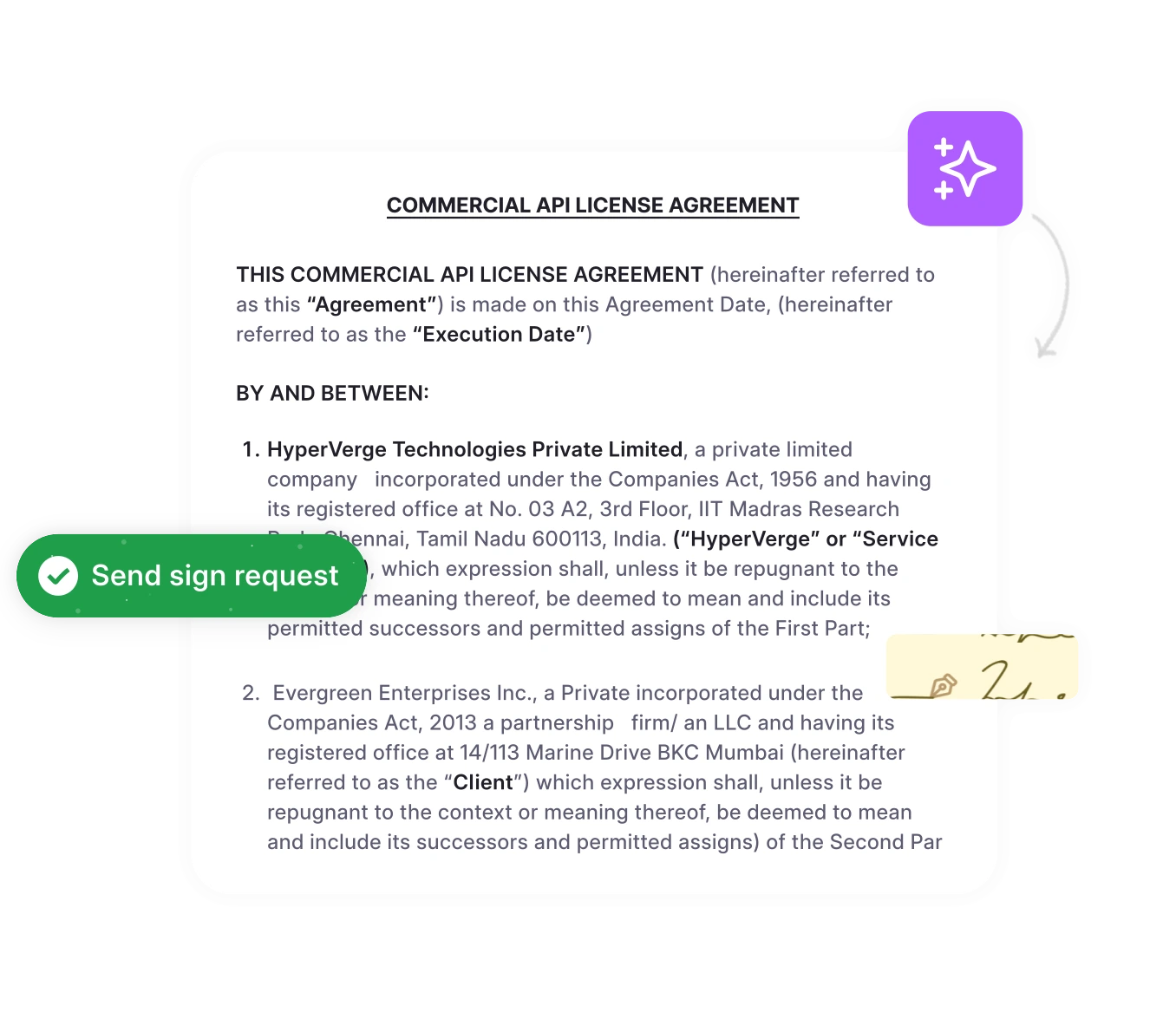Contract changes are inevitable. They may be triggered by employers, contractors, internal or external factors. But, they can be tedious without clear frameworks. Contracts get misplaced. Context is lost. Approvals are delayed. Risks increase. And opportunities go unclaimed.
Good contract change management comes down to having:
- Clear policies that everyone understands
- A plan for potential risks before they happen
- Robust frameworks to track, document, and communicate these changes
Before we learn how to implement this, let’s first define contract change management.
What is contract change management and why is it important?
Contract change management is the process of identifying, planning, implementing, and managing modifications in a contract after everyone has signed it. The contract becomes legally binding after signatures and all parties are obliged to fulfil responsibilities. And as business circumstances evolve contracts often need to change as well.
Contracts can change for one or more of the following reasons like
- More control over the project
- Address operational issues
- Implement pre-decided changes
- Comply with the statutory authority
- Respond to change requests from either party
Types of contract changes
There are three main types of contract changes:
📄 Administrative changes: They don’t alter the scope work or the rights of either party. They include modifications in payment methods, typos, and contract language.
🔗 Substantive changes: They affect both signing parties and involve modifications in price delivery schedules, quantities or deliverables, or terms and conditions that involve obligations, risk, and liability.
➕ Constructive changes: They go beyond the original scope and are formalized through an amendment. They include suggestions to contractors, faster delivery schedules, and changes in the sequence of tasks.
Automate contract changes with ease
Edit, redline, and approve contract changes 3x faster with HyperStart’s smart Word integration
Book a DemoWhy do contract changes happen?
Shifting scope
Projects do not always go as planned. Scope changes occur when new requirements come up. Prices, timelines, or outcomes need to be redefined to suit the new change order.
Example: Imagine needing six conference rooms instead of the four specified in the original contract.
Market dynamics
Dynamic market conditions influence shifts in price, the competitive landscape, and customer behavior. Here, contract changes are crucial to compete and stay relevant.
Example: When chocolate prices triple overnight, the all-time favorite chocolate brand needs to negotiate prices to keep the project viable.
Legal & regulatory changes
New regulations get passed and existing ones are updated periodically. Compliance with them contributes to the success of the project.
Example: A civil engineer advises ESG compliant standards updated in contracts anticipating a regulatory bill in the next term.
Organizational changes
Changes in an organization like mergers, acquisitions, and changes in people or processes can impact the business. Updating contracts to reflect new realities is crucial.
Example: Consider an organization with a distributed workforce ecosystem. Frequent changes in people and workforce management practices calls for rapid bulk updates across employment contracts.
Performance challenges
Performance issues in project operations can be newly discovered or driven by pre-established performance standards and targets. Contract changes help overcome them.
Example: Due diligence of contractual obligations reveals a wage inflation that’s eroding margins.
Unforeseen circumstances
Events like natural disasters, pandemics, legislative changes, or strikes dramatically impact projects. Contract changes help redefine outcomes or terminate the contract.
Example: The state government mandates enhanced earthquake protections.
Whether small or major overhauls, managing contract changes well is integral to running a successful project or business.
Benefits of contract change management
Effective change management promises multiple benefits. Let’s see how they serve your business.
- Enhanced flexibility
The organization becomes adaptive to new situations. Flexible collaboration helps gain speed, improve visibility, and reduce costs.
- Better compliance and risk mitigation
You stay legally compliant and steer clear of penalties. Streamlined processes, clear documentation, and precedent language prevents risks down the road.
- Stronger stakeholder engagement
You communicate clearly, fortify relationships, and power the legal function to drive business.
Not all change requests are beneficial, welcome, or sound. Even if they were, they need to be free from legal risk. The next section spells out core guiding principles that make contract changes valid.
4 Guiding principles of contract change management
Principles that guide effectual contract change management processes:
Involve only necessary people like project managers, required stakeholders, and parties involved directly.
Why: It avoids unnecessary delays and conflicting inputs from multiple stakeholders.
Stay within legal boundaries so they are valid and can be governed and managed under courts of law.
Why: Contracts and contract changes are only valid and enforceable in courts of law when they are within legal frameworks.
Include only what’s needed and maintain original scope.
Why: Staying laser-focused on the contract issue at hand helps isolate the problem without undue importance to already approved terms in the contract.
Focus on the desired outcomes for the most efficient path to the change.
Why: Outcome-focused change management keeps all parties aligned on what truly matters, preventing scope creep and unvetted changes.
The goal of contract change management is not to avoid changes but to take them in your stride while you stay relevant, competitive, and flexible to adapt. A change that abides by these principles is better equipped to transform project killers into manageable adjustments. It redeems time, budgets, and most importantly between all parties involved.
The next section explores the key pain points these principles address.
Overcoming pain points in the change management process
Contract change management is far more than mundane paperwork. It is a strategic process that needs meticulous oversight from planning to execution. Let’s explore some typical pain points and how to overcome them.
New risk potential
🌀 Challenge: New changes are likely to invite the potential for new risk from modified obligations, timelines, and deliverables.
🎯 Solution: Create a risk matrix for proposed changes. Counter them with clear and consistent communication. Address each new contract term with transparency.
Dealing with stakeholders
🌀 Challenge: Balancing the interests of different contracting parties with different priorities is not easy.
🎯 Solution: Predetermine guardrails with legal to maintain the integrity of the exercise. Streamline collaborative working sessions between niche experts and external teams at necessary stages.
Time and resource constraints
🌀 Challenge: Contract changes are resource-intensive. Administrative work impacts scope, timeline, budget, and resource allocation.
🎯 Solution: Set realistic timeframes, benchmark templates for documentation, plan meticulously, and phase implementation to overcome resource bottlenecks.
Scope creep
🌀 Challenge: Scope creep is an unapproved deviation from the project plan. Imagine you’ve signed a commercial construction project. Unvetted add-on requests like a larger lobby here, premium fixtures there, and extended parking spaces without formal change orders can incur costs, cause delays, and create friction later.
🎯 Solution: Establish clear boundaries and KPI tracking to measure success. Regular audits can overcome the challenge of scope creep.
Steps: How to change a contract effectively (steps 0–10)
The goal of a good contract change management process is to ensure changes happen safely, legally, and effectively. Any significant contract change is likely to raise risks, disrupt core processes, and put a strain on business relationships. It is best done systematically in the following steps.
Step 0: Identify the contract issue
“Something helpful to remember is don’t assume that by identifying the change, it ends there or is isolated. Really assess the ramifications and if it will require changes in other areas, affect other costs, etc. Sometimes it is a domino effect.”
Kelly Ann Kirkconnell, Facilities Analyst with O&G advises
Contract issues are triggered either internally or externally. Identifying the nature, scope, and impact of the change is prerequisite to going about making the change. Determine if the issue affects a single contract, a subset or a large volume of contracts.
Consider a scenario where a client wants to shift timelines and expand the engineering team. This raises flags across deliverables, costs, and dependencies.
Read more on contract amendment here.
Step 1: Document
“Document. Document. Document…recalling off the top of your head is not a legal document.”
Ashton Jones, Contracting Team Lead at Bureau of Reclamation
Initial documentation forms the basis for all subsequent steps in the change management process. They include:
- Document the issue and reasons for the change
- Outline expected benefits of making the change
- Provide context with supporting documents
Project leads document the timeline shift request, justify it with new goals, and attach relevant communication.
Step 2: Prioritize fixes
When the contract issues are defined, use data to guide how you assess and prioritize them.
- Evaluate the importance and urgency of each request
- Determine if a quick fix will suffice or if it needs deeper consideration
- Analyze levels of complexity, cost, and timing factors and their impact
The team now recognizes that fast delivery is critical. They explore whether current staffing could meet needs or if expansion is essential.
Step 3: Prepare contract change request
After contract changes are vetted and prioritized, create a formal change request document. This will function as the operating document during the change process.
- Assign a numbered entry to track changes easily
- Articulate relevant details and the rationale for the change
- Establish the document as an audit trail that covers contract changes
Meanwhile, a formal change request is drafted, including the revised scope and a unique ID to track it. It’s logged for audit purposes.
Step 4: Streamline and submit change requests
During this stage, thoroughly analyze proposed changes and what would make it successful.
- Assess technical requirements and compatibility with existing tools and systems
- Consult with expert teams for specialized input
Meanwhile, engineering and procurement teams are consulted to check if the change is viable and if resources can be aligned.
Step 5: Measure impact and propose changes
This critical step requires careful analysis of how the change will affect various aspects of the contract:
- Assess impact of change on project scope, timeline deliverables, and the financials
- Create a detailed proposal for the contract amendment
- Establish KPIs for necessary internal and external stakeholders
The contracting lead or project manager shares a cost-benefit breakdown with leadership. Impact on timeline, team bandwidth, and budget is laid out with KPIs.
Step 6: Negotiate
Once the impact assessment is complete, engage in structured negotiations:
- Propose changes to, discuss new terms, and find middle ground with relevant parties
- Communicate implications of the changes clearly
- Get consent for all of the above
The client and vendor articulate new expectations—middle ground is found on budget and deliverables.
Step 7: Get approval from legal
Legal oversight is essential for protecting all parties involved:
- Send proposed changes to legal teams for review
- Make sure you comply with regulatory laws
The legal team reviews the revised contract for compliance and protects both sides from risk.
Step 8: Formalize and sign off
After negotiations and legal approval:
- Formally document agreed-upon changes
- Detail the new scope, timeline, budget, and new deliverables
- Have both parties review and formally sign off on changes
Once legal clears it, the contract is updated. Both parties sign off on the extended team, new deliverables, timelines, and outcomes.
Step 9: Implement the change
Implementation requires careful coordination:
- Communicate clearly and and educate teams thoroughly during implementation
- Monitor and address any issues promptly and optimize resources for maximum value
The expanded engineering team is onboarded. Project manager aligns all workflows with the new scope.
Step 10: Post-change evaluation
After implementation, conduct a thorough review:
- Document learnings, evaluate effectiveness, and update organization protocols
- Share insights with stakeholders and identify opportunities for improvement
After delivery, the team evaluates the project’s success and logs lessons learned for future change requests.
Managing contract changes is about safeguarding relationships, staying compliant, and handling each step with clarity and confidence. Each change, whether simple or complex, is an opportunity to reinforce trust and deliver smarter.
One platform for every contract change
Create, edit, approve, sign, and store amendments—all inside HyperStart CLM. Manage the full contract lifecycle effortlessly.
Book a Demo7 Best practices for contract change management process
Changes can be random or regular, simple or complex, and triggered from within or outside the organization. This section encourages you to deliver the best possible experience regardless through the change management process.
1. 📙 Establish clear policy and procedure
Develop a structured policy that defines procedures, roles, responsibilities, and approval levels. Make sure that it is reliable and streamlined for efficiency. The process should contain the steps we outlined earlier.
2. 🗣️ Communicate clearly and transparently
Maintain open communication about proposed changes, reasons for change, and expected outcomes. Address aspects like compliance, financial implications, project timelines, operational processes so all stakeholders understand what is changing and why.
3. 🤹 Proactively manage risks
Anticipate and address contractual risks from missed deadlines and payment terms. Spot them early before they escalate.
4. 📂 Create a single source of truth
Maintain thorough documentation on a central repository. CLM technology helps keep a safe record of all contracts, associated emails, communications, approvals, and change logs.
5. ⏪ Reviewing periodically
Conduct post-implementation reviews to evaluate effectiveness. Use learnings to optimize future projects. Track metrics of success and identify areas for improvement.
6. 👥 Train and develop skill capacity
Make sure team members understand and adopt both operational and compliance requirements. Invest in training programs so they are equipped for organization-wide change.
7. 💪 Embrace flexibility and adaptability
Design processes that can accommodate changes to evolve with organizational needs.
Make sure they are flexible to remain relevant and effective as the business environment changes.
A successful contract change management process involves thorough documentation, consistent communication, proactive risk management, and continuous improvement. Each of these best practices can be supercharged with technology you don’t have to do the heavy-lifting.
Let’s see how.
Leveraging technology for contract change management
When managing contract amendments, a technology can transform complexity to clarity. Here’s how HyperStart automated contract management software does it.
Intelligent repository management
After execution, contract changes will automatically move and rest in a central contract repository—linking them to associated contracts. AI-filters help locate what you need quickly. Granular version control and audit trails provide robust governance over the contract lifecycle.
AI-powered obligation tracking
HyperStart’s AI extraction capabilities transform static documents into actionable insights. You can track key dates and obligations and update dashboards in real time. Timely reminders ensure nothing falls through the cracks.
Integrations
Modern contract management systems connect with CRM and ERP platforms for seamless information flow.
These integrations improve visibility and foster cohesive collaboration between internal teams across the organization.
HyperStart’s repository, audit trails, and AI tracking help organizations reduce risk and administrative burden while improving visibility, compliance, and collaboration. The result: you stay on top of obligations with minimal effort.
Get a walkthrough today. Book a demo.









